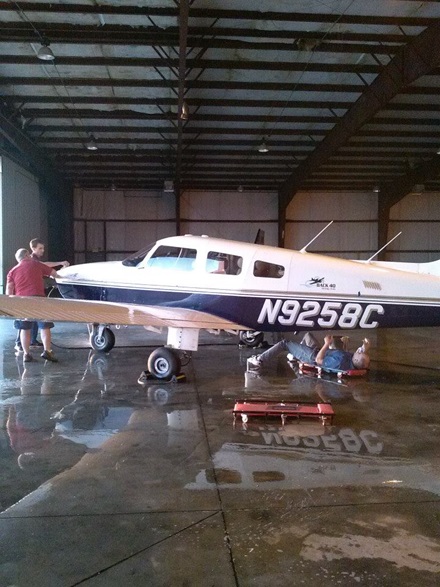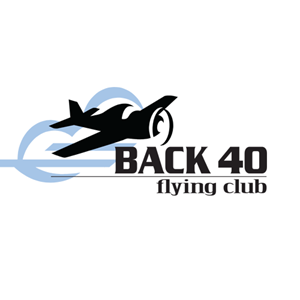The Back 40 Flying Club based at Fort Wayne International Airport (FWA) in Indiana has been around since 1952. The club has had stable leadership and the 17 members had no problems booking either the club’s Cherokee Archer or Cessna 172. The club ran smoothly, doing things as it always had for many years.
But 2019 was a year of change. In the summer the treasurer stepped down and in November the president moved out of state to pursue a career opportunity. Although the new president and treasurer were existing board members who stepped up to fill the vacant positions, the turnover in the board resulted in the club evaluating their operations and making some changes.
“The majority of the board in six months went from being a bunch of older members to a bunch of younger people who are excited and motivated to change,” new Treasurer Colin Gibb said.
One of the first things the new board took on was updating the club’s website and modernizing its operations. This had an immediate impact – for current and potential members.
Member Benefits
The club changed its online scheduler to Flight Circle, in part because it gave members the opportunity to electronically log their time and electronically report maintenance squawks. Prior to this change, time and squawks were written on paper and the maintenance officer and treasurer would physically have to go to the airport to get the sheets.
The club also liked that Flight Circle could link with Quickbooks, which made billing fairly automated. The club also added a PayPal account so dues and aircraft use payments could be made electronically. Prior to updating their web page, “payments were only accepted by check and everything was done by paper,” Colin said. “The club went all electronic with check-in logs online, and we enabled online payments for the first time.”
These changes reduced the workload for the board members and made the club attractive to new members. “All these little things, when new members look at joining a club, they see it is modern, everything is convenient and online. And that attracts people,” Colin said.
Improving Search Engine Optimization
Attracting people was the biggest benefit of updating the website. One of the key ways potential members will find your club is by searching the Internet. As we all know, if you type in a few key words you’ll get a list of websites.
What the Back 40 Flying Club found was that its old website was not optimized for mobile devices, which had two negative effects. First, anyone using a phone or tablet to view the club website didn’t have a good experience. Older websites that aren’t optimized for mobile devices are hard to read and navigate from the palm of your hand. Which means people won’t stay on your site very long.
But more importantly, if your website is not mobile-friendly, it will fall well down in search engine results, even on a computer. The club’s old website was not optimized for mobile devices, and when doing a search, the Back 40 web page would be all the way down on the sixth or seventh page of search results.
“There are numerous articles about how Google and Bing prioritize hits based on content,” said Kyle Schwyn, the Club Board Member who did the website redesign using WordPress. “They look for relevancy. Updated pages that aren’t stale is a good thing.”
Google, likes to optimize its search engine with sites that are mobile-based or that are considered dynamic, meaning the web site will adjust to whatever size screen you have on any device.
When the club updated its website, one of the key factors was to make it mobile friendly for visitors. But an equally important factor was to use a platform that didn’t require knowing the ins and outs of programming to maintain the site.
“WordPress is one of the easiest visual editors to use so you don’t have to know programming at all,” Kyle said. “Anybody can log in and develop content or change pages as long as they understand how [Microsoft] Word works, or PowerPoint.”
Using WordPress allowed the club to build a platform that has plenty of capability but is also simple to use. The site uses a lot of drag and drop features making it easy to create an attractive site. And there are lots of tutorial videos that can guide you through the process of using WordPress.
The club launched the new site last summer. In just a few days, they saw the Back 40 website appearing in the first few listings when doing a search, rather than being buried in a long list.
In addition, the club starting using its Facebook page, which they had not been actively using. There are three members who are administrators of the page who began posting and adding info with the goal of driving people to the club’s website. The results were startling.
Attracting New Members
“Between Facebook and the website being more visible, our membership officer will probably get three or four inquiries a month that are serious,” Colin said. “We’ve been acquiring about an average of one new member a month for the past few months.”
Since updating the website, the club has grown from 17 members to 26 in the past six to eight months. And with increased members, there has been an increase in flying – all because of the improved website and greater social media presence.
Colin emphasized the most important thing the club learned is having a website that is mobile friendly so it is optimized in search engines and user-friendly no matter what device someone is using. But what are some other elements that make a good club website?
Tips for Setting Up Your Club Website
A flying club’s web page is essentially the front door to your organization. It’s the first place most people will go to get information about your club. It’s important to present the message and face you want to portray so prospective members get a sense of the club and its operations. But keep in mind your web site is not just for the outside world, it’s a tool for your members as well. Here are a few tips on what to include on your website.
There are two main elements of a website – the content or information you provide and how it looks. The presentation should be simple and your page should be easy to navigate.
The best club websites are visually engaging, with photos or videos of the club planes and members, especially photos of events with members interacting. Photos are a great way to create a feeling for a club and provide information in a subtle way. For example, if there are photos of members having fun during a plane wash, it will demonstrate camaraderie, that members work together, and the planes are well maintained.
How do you let someone know you have a strong safety culture – include a picture of a safety seminar. Is the social aspect a key element for your club? Show photos of members having fun together. Do your members enjoy taking trips – include photos or videos of the interesting destinations they’ve been to.
While the look and feel will help create an image of the club in a visitor’s mind, the content is even more important. Prospective members are looking for information about the club. It’s important to provide a detailed overview but remember too keep it concise. Too much information can be overwhelming and turn people off.
People like dynamic pages that have original content that is updated regularly. That can be done with a blog sharing safety tips, member profiles, or a short write-up on a trip a member took in the club plane. And posting photos of recent club activities helps as well.
Another important point is to be sure your club does not state or imply that the general public can “learn to fly with us.” This is considered “holding out” for business, which is the realm of commercial operators, not non-profit flying clubs. For a more detailed understanding of this, see the January 2018 Club Connector Question of the Month.
What every club website should have is some basic information that may be organized in the following categories or pages:
About: This is where you include a brief description of the club. It can be a short history, and may include the club’s purpose and mission statement.
Contact: At the very least, there should be an email, and if you can include a phone number, that is helpful.
Membership: This section should provide the requirements to become a member and the costs, including monthly dues and joining fees. You may also include hourly rates for the aircraft. It is helpful to specify whether you use Tach time or Hobbs.
Aircraft/Fleet: This section should list the aircraft with basic specs and performance, particularly if your club has multiple aircraft. By doing so, it provides a comparison and allows visitors the chance to understand what they are buying into. Some helpful info you may include is year built, engine type and hp, useful load, fuel capacity, range, and avionics.
Online Scheduler: If your club uses an online scheduler, it should be easily accessible to your members on the website.
Documents: This could be a member-only section requiring a log in or something available to the public, depending on what your club chooses. This is where you can have the bylaws, club rules or operating procedures, safety documents, pilot operating handbooks, avionics and maintenance manuals. This type of openness goes a long way in attracting people who are really interested, rather than those wishing to “kick the tires.”
News: If your club has a newsletter, post it online. It saves you the cost of postage, and you can create an archive to read back issues. If you don’t have a newsletter, consider a blog. It’s a great way to add content that is generally on a single topic and more concise than a newsletter. You can use a news section to post information about upcoming or past events. This section helps keep current members informed about club activities and it also gives visitors are sense of the club, its mission and values. The more dynamic you can make your site in terms of new information being added on a regular basis, the more members will use the site.
Calendar This is another feature that is probably more important as a tool to keep members informed of club activities, but it’s also a good way to demonstrate how active a club is. Include things like monthly board meetings and upcoming social events. It doesn’t have to be limited to club activities. Include information about local air shows, an airport open house, Young Eagle events, or a safety seminar in the area. Having a calendar with events gives members a reason to visit your page, and helps keep the club relevant.
FAQs Some clubs like to have a Frequently Asked Questions page where the answers to the most common questions can be found quickly and easily.
Links: Having a page that links to aviation resources is another way to keep your club and its website relevant to members. Whether the links are to aviation organizations or weather and flight planning sites, it makes your website the place to go for information, providing a service and value to your members or visitors.
Factsheet
Name | Back40 Flying Club |
Location | Fort Wayne International Airport (FWA) Fort Wayne, IN |
Website | https://back40fc.com |
https://www.facebook.com/back40fc/ | |
Contact | [email protected] |
Year formed | 1952 |
Aircraft | 1995 Piper Archer ($120/hr) 1982 Cessna 172P ($120/hr) Rates are Tach time, wet. |
Joining fee | $600 refundable upon leaving the club |
Monthly dues | $85 per month |
Membership | 27 |
Scheduler | Flight Circle |
